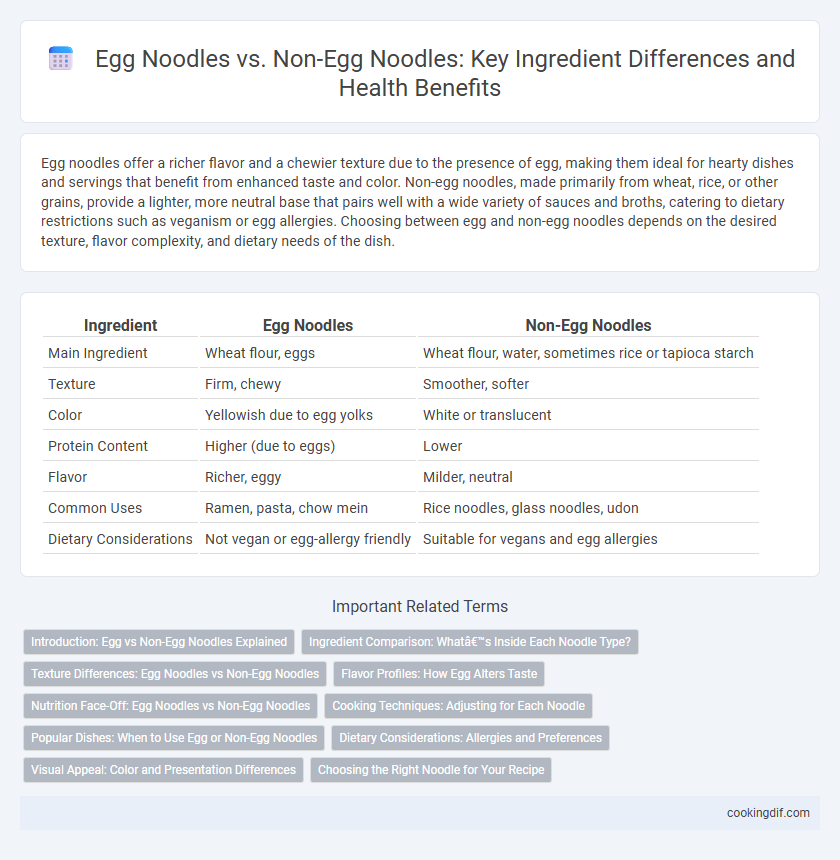Egg noodles offer a richer flavor and a chewier texture due to the presence of egg, making them ideal for hearty dishes and servings that benefit from enhanced taste and color. Non-egg noodles, made primarily from wheat, rice, or other grains, provide a lighter, more neutral base that pairs well with a wide variety of sauces and broths, catering to dietary restrictions such as veganism or egg allergies. Choosing between egg and non-egg noodles depends on the desired texture, flavor complexity, and dietary needs of the dish.
Table of Comparison
| Ingredient | Egg Noodles | Non-Egg Noodles |
|---|---|---|
| Main Ingredient | Wheat flour, eggs | Wheat flour, water, sometimes rice or tapioca starch |
| Texture | Firm, chewy | Smoother, softer |
| Color | Yellowish due to egg yolks | White or translucent |
| Protein Content | Higher (due to eggs) | Lower |
| Flavor | Richer, eggy | Milder, neutral |
| Common Uses | Ramen, pasta, chow mein | Rice noodles, glass noodles, udon |
| Dietary Considerations | Not vegan or egg-allergy friendly | Suitable for vegans and egg allergies |
Introduction: Egg vs Non-Egg Noodles Explained
Egg noodles, rich in protein and imparting a distinct yellow hue, offer a firmer texture and richer flavor compared to non-egg noodles, which are typically made from wheat flour and water. Non-egg noodles provide a lighter taste and are often preferred for their neutral profile, making them versatile in diverse culinary applications and suitable for vegan diets. The choice between egg and non-egg noodles influences cooking time, texture, and nutritional content, with egg noodles generally delivering a more robust bite and nutritional density.
Ingredient Comparison: What’s Inside Each Noodle Type?
Egg noodles contain wheat flour, eggs, and water, giving them a richer flavor and a chewier texture due to the protein and fat from the eggs. Non-egg noodles typically consist of wheat flour and water, resulting in a lighter texture and a more neutral taste that pairs well with various sauces and broths. The presence of egg also increases the noodle's color vibrancy, turning it a yellowish hue, while non-egg noodles remain pale or white.
Texture Differences: Egg Noodles vs Non-Egg Noodles
Egg noodles have a rich, chewy texture due to the protein and fat content from eggs, providing a firmer bite and a slightly springy mouthfeel. Non-egg noodles, often made from wheat flour and water alone, tend to be softer and less elastic, resulting in a smoother, more delicate texture. The presence of egg also enhances the noodle's ability to hold sauces better, contributing to a more robust eating experience compared to non-egg varieties.
Flavor Profiles: How Egg Alters Taste
Egg noodles offer a richer, creamier flavor profile due to the natural fats and proteins in eggs, which deepen the overall taste and provide a subtle savory note. Non-egg noodles tend to have a lighter, more neutral flavor, allowing sauces and seasonings to stand out without interference. The egg's presence enhances mouthfeel and adds a slight sweetness, making egg noodles distinctively flavorful compared to their non-egg counterparts.
Nutrition Face-Off: Egg Noodles vs Non-Egg Noodles
Egg noodles typically contain higher protein and vitamin B12 levels compared to non-egg noodles due to their inclusion of eggs. Non-egg noodles, often made from wheat or rice flour, offer lower fat and cholesterol content, making them suitable for vegan or cholesterol-conscious diets. The choice between egg and non-egg noodles hinges on nutritional priorities like protein intake versus lower cholesterol and fat consumption.
Cooking Techniques: Adjusting for Each Noodle
Egg noodles require shorter boiling times and careful temperature control to prevent overcooking, as the protein structure makes them more delicate. Non-egg noodles benefit from longer soaking or boiling, allowing them to soften without becoming mushy, due to the absence of egg proteins. Adjusting water temperature and cooking duration enhances texture and flavor, optimizing each noodle type's culinary performance.
Popular Dishes: When to Use Egg or Non-Egg Noodles
Egg noodles, rich in protein and with a chewier texture, are ideal for dishes like chicken noodle soup and stroganoff, where a robust mouthfeel complements the hearty flavors. Non-egg noodles, often made from rice or wheat flour without eggs, provide a lighter, more neutral base perfect for delicate broths and stir-fries such as pho or pad thai. Choosing between egg or non-egg noodles depends on the desired texture and flavor pairing to enhance popular Asian and Western recipes.
Dietary Considerations: Allergies and Preferences
Egg noodles contain proteins that can trigger allergic reactions, making non-egg noodles a safer choice for individuals with egg allergies or sensitivities. Non-egg noodles, often made from wheat, rice, or other grains, cater to vegan or egg-free dietary preferences without compromising texture. Selecting the appropriate noodle type ensures compliance with dietary restrictions and supports diverse nutritional needs.
Visual Appeal: Color and Presentation Differences
Egg noodles exhibit a rich yellow hue due to the natural pigments in egg yolks, creating a visually vibrant and appetizing presentation. In contrast, non-egg noodles tend to have a pale or off-white color, offering a more neutral canvas that highlights accompanying sauces and garnishes. The color contrast in egg noodles enhances dish aesthetics, making them preferable for visually striking culinary presentations.
Choosing the Right Noodle for Your Recipe
Choosing the right noodle for your recipe depends on the texture and flavor profile desired, where egg noodles offer a richer taste and firmer bite due to their high protein content. Non-egg noodles, often made from wheat or rice flour, provide a lighter, more neutral base, ideal for dishes that emphasize broths or sauces. Consider dietary preferences and cooking times, as egg noodles generally cook faster and enhance heartiness, while non-egg noodles are suitable for vegan diets and absorb flavors differently.
Egg vs non-egg for noodle ingredients Infographic

 cookingdif.com
cookingdif.com